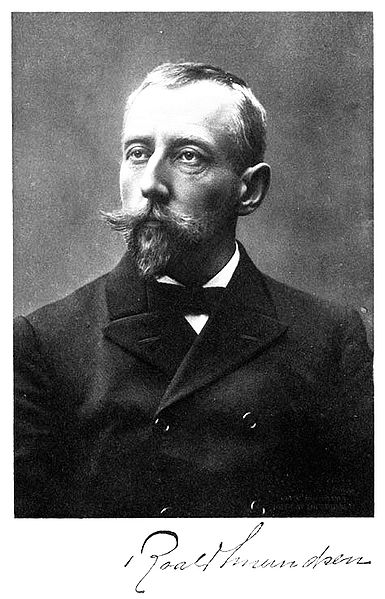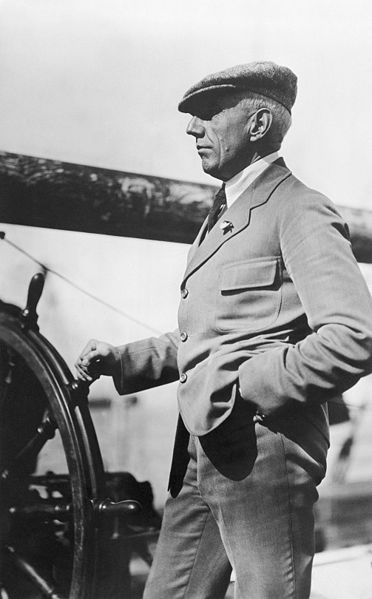<Back to Index>
- Explorer Roald Engelbregt Gravning Amundsen, 1872
- Painter Sir Joshua Reynolds, 1723
- 1st Secretary-General of the United Nations Trygve Halvdan Lie, 1896


Roald Engelbregt Gravning Amundsen (16 July 1872 – c. 18 June 1928) was a Norwegian explorer of polar regions. He led the first Antarctic expedition to reach the South Pole between 1910 and 1912. He was also the first person to reach both the North and South Poles. He is known as the first to traverse the Northwest Passage. He disappeared in June 1928 while taking part in a rescue mission. Amundsen with Douglas Mawson, Robert Falcon Scott, and Ernest Shackleton, was a key expedition leader during the Heroic Age of Antarctic Exploration.
Amundsen was born to a family of Norwegian shipowners and captains in Borge, between the towns Fredrikstad and Sarpsborg. His father was Jens Amundsen. The fourth son in the family, his mother chose to keep him out of the maritime industry of the family and pressured him to become a doctor, a promise that Amundsen kept until his mother died when he was aged 21, then quitting university for a life at sea. Amundsen had hidden a lifelong desire inspired by Fridtjof Nansen's crossing of Greenland in 1888 and the doomed Franklin expedition. As a result, he decided on a life of intense exploration.
He was a member of the Belgian Antarctic Expedition (1897–99) as first mate. This expedition, led by Adrien de Gerlache using the ship the Belgica, became the first expedition to winter in Antarctica. The Belgica, whether by mistake or design, became locked in the sea ice at 70°30'S off Alexander Island, west of the Antarctic Peninsula. The crew then endured a winter for which the expedition was poorly prepared. By Amundsen's own estimation, the doctor for the expedition, American Frederick Cook, probably saved the crew from scurvy by hunting for animals and feeding the crew fresh meat, an important lesson for Amundsen's future expeditions.
In 1903, Amundsen led the first expedition to successfully traverse Canada's Northwest Passage between the Atlantic and Pacific Oceans (something explorers had been attempting since the days of Christopher Columbus, John Cabot, Jacques Cartier, and Henry Hudson), with six others in a 47 ton steel seal hunting vessel, Gjøa. Amundsen had the ship outfitted with a small gasoline engine. They travelled via Baffin Bay, Lancaster and Peel Sounds, and James Ross, Simpson and Rae Straits and spent two winters near King William Island in what is today Gjoa Haven, Nunavut, Canada. During this time Amundsen learned from the local Netsilik people about Arctic survival skills that would later prove useful. For example, he learned to use sled dogs and to wear animal skins in lieu of heavy, woolen parkas. After a third winter trapped in the ice, Amundsen was able to navigate a passage into the Beaufort Sea after which he cleared into the Bering Strait, thus having successfully navigated the Northwest Passage. Continuing to the south of Victoria Island, the ship cleared the Canadian Arctic Archipelago on August 17, 1905, but had to stop for the winter before going on to Nome on the Alaska Territory's Pacific coast. Five hundred miles (800 km) away, Eagle City, Alaska, had a telegraph station; Amundsen travelled there (and back) overland to wire a success message (collect) on December 5, 1905. Nome was reached in 1906. Due to water as shallow as 3 ft (0.91 m), a larger ship could never have used the route.
It was at this time that Amundsen received news that Norway had formally become independent of Sweden and had a new king. Amundsen sent the new King Haakon VII news
that it "was a great achievement for Norway." He hoped to do more he
said and signed it "Your loyal subject, Roald Amundsen." After crossing the Northwest Passage, Amundsen made plans to go to the North Pole and explore the North Polar Basin. Amundsen had problems and hesitation raising funds for the departure and upon hearing in 1909 that first Frederick Cook and then Robert Peary claimed the Pole, he decided to reroute to Antarctica. However, he did not make these plans known and misled both the Englishman, Robert F. Scott and the Norwegians. Using the ship Fram ("Forward"), earlier used by Fridtjof Nansen, he left Norway for the south, leaving Oslo on June 3, 1910. At Madeira,
Amundsen alerted his men that they would be heading to Antarctica in
addition to sending a telegram to Scott notifying him simply: "BEG TO INFORM YOU FRAM PROCEEDING ANTARCTIC -- AMUNDSEN." The expedition arrived at the eastern edge of Ross Ice Shelf at a large inlet called the Bay of Whales on January 14, 1911, where Amundsen located his base camp and named it Framheim. Further, Amundsen eschewed the heavy wool clothing worn on earlier Antarctic attempts in favour of Eskimo-style skins. Using skis and dog sleds for
transportation Amundsen and his men created supply depots at 80°,
81° and 82° South on the Barrier, along a line directly south
to the Pole. Amundsen
also planned to kill some of his dogs on the way and use them as a
source for fresh meat. A premature attempt, which included Hjalmar Johansen, Kristian Prestrud and Jørgen Stubberud,
set out on 8 September, 1911, but had to be abandoned due to extreme
temperatures. The painful retreat caused a tempering quarrel within the
group, with the result that Johansen and others were sent to explore King Edward VII Land. A second attempt with a team, consisting of Olav Bjaaland, Helmer Hanssen, Sverre Hassel, Oscar Wisting, and Amundsen himself, departed on October 19, 1911. They took four sledges and 52 dogs. Using a route along the previously unknown Axel Heiberg Glacier they
arrived at the edge of the Polar Plateau on November 21 after a
four-day climb. On December 14, 1911, the team of six, with
16 dogs, arrived at the Pole (90°00'S). They arrived
35 days before Scott’s group. Amundsen named their South Pole camp Polheim, “Home on the Pole.” Amundsen renamed the Antarctic Plateau as
King Haakon VII’s Plateau. They left a small tent and letter stating
their accomplishment, in case they did not return safely to Framheim.
The team returned to Framheim on January 25, 1912, with 11 dogs.
Amundsen’s success was publicly announced on March 7, 1912, when he
arrived at Hobart, Australia. Amundsen’s
expedition benefited from careful preparation, good equipment,
appropriate clothing, a simple primary task (Amundsen did no surveying
on his route south and is known to have taken only two photographs), an
understanding of dogs and their handling, and the effective use of
skis. In contrast to the misfortunes of Scott’s team, the Amundsen’s
trek proved rather smooth and uneventful. In Amundsen’s own words: Amundsen wrote about the expedition in The South Pole: an account of the Norwegian Antarctic Expedition in the "Fram", 1910-12, published in 1912. In 1918, Amundsen began an expedition with a new ship Maud, which was to last until 1925. Maud sailed West to East through the Northeast Passage, now called the Northern Route (1918-1920). Amundsen planned to freeze the Maud into the polar ice cap and drift towards the North Pole (as Nansen had done with the Fram), but in this he was not successful. However, the scientific results of the expedition, mainly the work of Harald Sverdrup, were of considerable value. Many of these carefully collected scientific data had been lost during the ill-fated journey of Peter Tessem and Paul Knutsen, two crew members sent on a mission by Amundsen, but they were later retrieved by Russian scientist Nikolay Urvantsev as they lay abandoned on the Kara Sea shores. In 1923, Amundsen and Oskar Omdal, of the Royal Norwegian Navy, attempted to fly from Wainwright, Alaska, to
Spitsbergen across the North Pole. Amundsen and Omdal's aircraft was
damaged and they abandoned the journey. In 1925, accompanied by Lincoln Ellsworth, pilot Hjalmar Riiser-Larsen, and three other team members, Amundsen took two Dornier Do J flying boats,
the N-24 and N-25 to 87° 44' north. It was the
northernmost latitude reached by plane up to that time. The planes
landed a few miles apart without radio contact, yet the crews managed
to reunite. One of the aircraft, the N-24 was damaged. Amundsen and his
crew worked for over three weeks to clean up an airstrip to take off
from ice. They shoveled 600 tons of ice while consuming only one pound
(400 g) of daily food rations. In the end, six crew members were
packed into the N-25. In a remarkable feat, Riiser-Larsen took off, and
they barely became airborne over the cracking ice. They returned
triumphant when everyone thought they had been lost forever. In
1926, Amundsen and fifteen other men (including Ellsworth,
Riiser-Larsen, Oscar Wisting, and the Italian air crew led by
aeronautical engineer Umberto Nobile) made the first crossing of the Arctic in the airship Norge designed by Nobile. They left Spitsbergen on
11 May 1926, and they landed in Alaska two days later. The three
previous claims to have arrived at the North Pole – by Frederick Cook
in 1908; Robert Peary in 1909; and Richard Evelyn Byrd in 1926 (just a few days before the Norge)
– are all disputed, as being either of dubious accuracy or outright
fraud. Some of those disputing these earlier claims therefore consider the crew of the Norge to be the first verified explorers to have reached the North Pole. If the Norge expedition
was actually the first to the North Pole, Amundsen and Oscar Wisting
would therefore be the first persons to attain each geographical pole,
by ground or by air, as the case may be. Amundsen disappeared on
June 18, 1928, while flying on a rescue mission with Norwegian pilot
Leif Dietrichson, French pilot Rene Guilbaud, and three more Frenchmen,
looking for missing members of Nobile's crew, whose new airship Italia had crashed while returning from the North Pole. Afterwards, a wing-float and bottom gasoline tank from the French Latham 47 flying boat he was in, improvised into a replacement wing-float, was found near the Tromsø coast. It is believed that the plane crashed in fog in the Barents Sea,
and that Amundsen was killed in the crash, or died shortly afterwards.
His body was never found. The search for Amundsen was called off in
September by the Norwegian Government. In 2003 it was suggested that
the plane went down northwest of Bear Island. Both in 2004 and in late August 2009 an unsuccessful search was made by the Royal Norwegian Navy for the wreckage of Amundsen's plane, using the unmanned submarine Hugin 1000. The search focused on a 40 square mile area of the sea floor, and was documented by the German production company ContextTV.